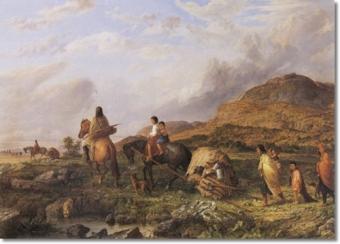This painting by Seth Eastman in 1869 is an interpretation of Dakota traveling using a travois (trah-voy). Courtesy of Architect of the Capitol.
In order to live close to food resources such as maple forests or ricing lakes, the Dakota had to pack and move their whole household. Since Dakota women owned the tipis and everything in them, packing and moving was usually women's work. Moving camp was hard, especially during the winter. Starting at daybreak, women and children packed and carried heavy bundles through snow and icy water, if the streams were not frozen.
In the early 1800s, Samuel Pond, a missionary who traveled with the Dakota said:
"Fourteen teepee poles were to be found and dragged often a considerable distance through the snow making two or three heavy loads for a strong woman. The tent was then erected, and dry grass cut up from some swamp was brought and put all around the tent or teepee on the outside, for the Indian women would not bank their tents with snow lest is should melt and injure the tent. Hay was also strewn inside to spread the beds on, for the frozen ground was hard and cold. Then wood was brought for the fire, very dry for they burn no other. Las of all water was brought and hung over the fire to warm or cook supper, which by this time was well earned if ever suppers are."
To here a contemporary perspective on traditional Dakota womens' work, click here.





